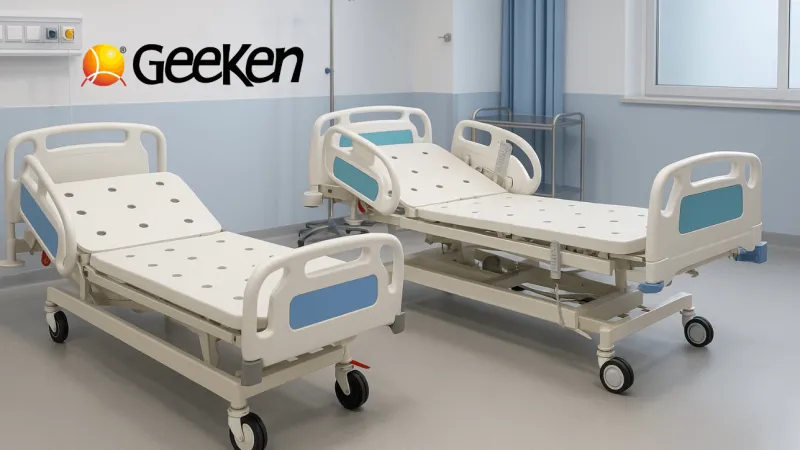Manual vs Motorized Beds: Which One Fits Your Hospital Setup?

Here's something that bothers me: hospitals treat hospital beds as commodity purchases rather than critical care infrastructure. I've consulted for healthcare facilities from tier-1 cities to smaller towns, and the bed decision impacts everything,patient recovery, nursing efficiency, infection control, and yes, your bottom line. Whether you're sourcing from hospital beds suppliers or evaluating motorized ICU beds versus manual alternatives, this decision deserves serious thought.
Understanding Manual Hospital Beds: The Traditional Workhorse
Let's start with manual hospital beds,the backbone of Indian healthcare for decades.
Manual beds use hand cranks (typically 2-3) to adjust head, foot, and height positions. Simple mechanics, minimal electronics, maximum reliability. I've seen 15-year-old manual beds still functioning perfectly in rural hospitals.
The real advantages:
Cost-effectiveness: A quality manual bed costs ₹25,000-₹45,000 compared to ₹1,50,000+ for motorized equivalents. For a 50-bed hospital, that's crores in savings.
Zero power dependency: Critical in areas with unreliable electricity. I consulted for a district hospital in UP where power cuts were daily,manual beds kept functioning regardless.
Simpler maintenance: Fewer moving parts mean less can break. Any decent mechanic can service manual beds. No specialized electronics technicians required.
Reliability: Manual mechanics rarely fail completely. A crank might get stiff, but the bed remains functional.
For general wards, maternity, and non-critical care, manual hospital beds from reputable hospital beds manufacturers make total sense. The cost-benefit math is compelling.
The Motorized Revolution: Electric ICU Beds
Now let's talk motorized ICU beds,where the technology genuinely transforms patient care.
Modern electric ICU beds feature push-button controls for multiple positions: head elevation, knee break, height adjustment, Trendelenburg, and reverse Trendelenburg. Some advanced models offer 5-8 functions controlled via remote or side panels.
Where motorized beds excel:
Critical care efficiency: ICU nurses adjust beds dozens of times per shift. Electric bed for patients eliminates physical strain and saves precious minutes during emergencies.
Patient independence: Conscious patients can adjust positions without calling staff. This psychological autonomy genuinely improves recovery outlook,I've seen patient satisfaction scores reflect this.
Precise positioning: Adjustable hospital beds with motorized controls achieve exact angles critical for respiratory therapy, cardiac care, and post-surgical positioning.
Pressure ulcer prevention: Frequent position changes reduce bedsore risk. Motorized ease means staff actually perform recommended adjustments.
Emergency speed: In code situations, Trendelenburg positioning happens in seconds with electric ICU beds,not minutes of frantic cranking.
The Cost-Benefit Reality
Let's address the elephant: motorized ICU beds cost 4-6 times more than manual beds. Is it worth it?
My framework: Match bed type to patient acuity.
General wards: Manual beds work fine. Patients are mobile, nursing ratios are higher, position changes are less frequent.
ICU/Critical care: Electric bed for patients becomes cost-effective. Time savings, better outcomes, and reduced nurse injury justify the investment.
Step-down units: Mix both. Keep 60-70% manual, 30-40% motorized for complex cases.
I worked with a 100-bed hospital in Gurgaon that wisely invested in motorized ICU beds for their 12-bed ICU and critical HDU, while keeping manual beds for general wards. This smart allocation maximized value without budget overruns.
Maintenance Reality: Hidden Costs
Let's talk about what happens six months after purchase,because that's where cheap beds reveal their true cost.
Manual bed maintenance is straightforward:
Lubrication every 3-6 months
Crank mechanism inspection
Frame integrity checks
Mattress replacement (every 3-5 years)
Annual maintenance cost: ₹2,000-₹5,000 per bed with in-house staff.
Motorized bed maintenance is more complex:
Motor functionality testing
Electronic control checks
Emergency manual override verification
All the manual bed checks plus electrical components
Annual maintenance cost: ₹15,000-₹25,000 per bed, often requiring specialized technicians.
However,and this is crucial,downtime matters. A malfunctioning ICU bed during census surge is a crisis. Quality motorized ICU beds from established hospital beds manufacturers in Delhi come with faster service response and better warranty support.
The Bottom Line: Patient-Centered Decision Making
Here's what matters most: hospital beds are where healing happens. Every decision should filter through this lens.
Will this bed improve patient comfort? Will it make nursing care more efficient? Will it support the clinical outcomes we're trying to achieve?
For a 20-bed ICU, I'd absolutely recommend electric ICU beds. For a 100-bed general ward, quality manual beds make complete sense. For an 8-bed HDU, maybe a 50-50 mix.
There's no one-size-fits-all answer. But there is a right answer for your specific facility, patient population, and budget. Take the time to find it.
Work with hospital beds suppliers who understand your context, not just salespeople pushing inventory. Ask questions, demand demos, talk to other hospitals using the same equipment.
Your patients,and your staff,deserve that diligence.
FAQs
Q1: What's the typical lifespan difference between manual and motorized hospital beds?
A: Quality manual beds last 12-15 years with proper maintenance,simpler mechanics mean longer life. Motorized ICU beds typically last 8-12 years before motors or electronics need major service/replacement. However, motorized beds often get upgraded sooner due to technology advances. Factor this into total cost of ownership calculations.
Q2: Can I convert my existing manual beds to electric beds later?
A: No, conversion isn't practical or safe. Motors, control systems, and frame reinforcements for electric beds are integrated during manufacturing. Retrofitting costs nearly as much as new beds with significant safety risks. Better to plan purchases correctly from the start or replace units systematically as budget allows.
Q3: How do I choose between different hospital beds suppliers in Delhi?
A: Evaluate: warranty length (5+ years for critical care beds), service response time (24-48 hours maximum), spare parts availability, existing installation references, and staff training provisions. Visit working installations if possible. Geeken's advantage is comprehensive post-sale support,not just selling beds but maintaining long-term relationships with healthcare facilities.
Copyright ©2025 Geeken. All Rights Reserved.



